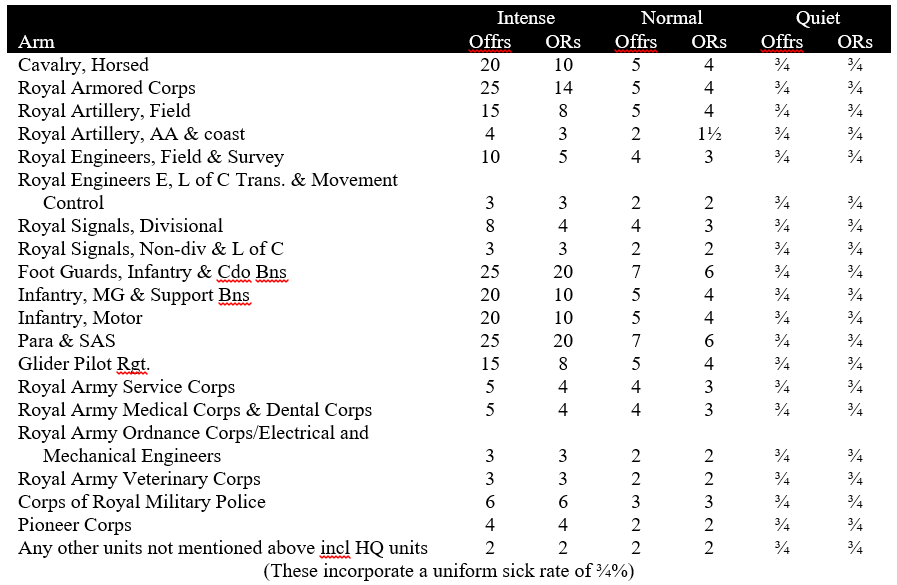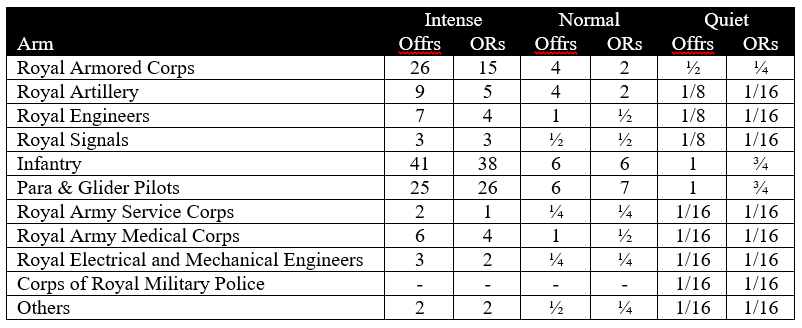
A friend of TDI queried us recently about a reference in Rick Atkinson’s The Guns at Last Light: The War in Western Europe, 1944-1945 to a British casualty estimation methodology known as “Evett’s Rates.” There are few references to Evett’s Rates online, but as it happens, TDI did find out some details about them for a study on casualty estimation. [1]
British Army staff officers during World War II and the 1950s used a set of look-up tables which listed expected monthly losses in percentage of strength for various arms under various combat conditions. The origin of the tables is not known, but they were officially updated twice, in 1942 by a committee chaired by Major General Evett, and in 1951-1955 by the Army Operations Research Group (AORG).[2]
The methodology was based on staff predictions of one of three levels of operational activity, “Intense,” “Normal,” and “Quiet.” These could be applied to an entire theater, or to individual divisions. The three levels were defined the same way for both the Evett Committee and AORG rates:
 The rates were broken down by arm and rank, and included battle and nonbattle casualties.
The rates were broken down by arm and rank, and included battle and nonbattle casualties.

The Evett Committee rates were criticized during and after the war. After British forces suffered twice the anticipated casualties at Anzio, the British 21st Army Group applied a “double intense rate” which was twice the Evett Committee figure and intended to apply to assaults. When this led to overestimates of casualties in Normandy, the double intense rate was discarded.
From 1951 to 1955, AORG undertook a study of casualty rates in World War II. Its analysis was based on casualty data from the following campaigns:
- Northwest Europe, 1944
- 6-30 June – Beachhead offensive
- 1 July-1 September – Containment and breakout
- 1 October-30 December – Semi-static phase
- 9 February to 6 May – Rhine crossing and final phase
- Italy, 1944
- January to December – Fighting a relatively equal enemy in difficult country. Warfare often static.
- January to February (Anzio) – Beachhead held against severe and well-conducted enemy counter-attacks.
- North Africa, 1943
- 14 March-13 May – final assault
- Northwest Europe, 1940
- 10 May-2 June – Withdrawal of BEF
- Burma, 1944-45
From the first four cases, the AORG study calculated two sets of battle casualty rates as percentage of strength per 30 days. “Overall” rates included KIA, WIA, C/MIA. “Apparent rates” included these categories but subtracted troops returning to duty. AORG recommended that “overall” rates be used for the first three months of a campaign.
The Burma campaign data was evaluated differently. The analysts defined a “force wastage” category which included KIA, C/MIA, evacuees from outside the force operating area and base hospitals, and DNBI deaths. “Dead wastage” included KIA, C/MIA, DNBI dead, and those discharged from the Army as a result of injuries.
The AORG study concluded that the Evett Committee underestimated intense loss rates for infantry and armor during periods of very hard fighting and overestimated casualty rates for other arms. It recommended that if only one brigade in a division was engaged, two-thirds of the intense rate should be applied, if two brigades were engaged the intense rate should be applied, and if all brigades were engaged then the intense rate should be doubled. It also recommended that 2% extra casualties per month should be added to all the rates for all activities should the forces encounter heavy enemy air activity.[1]
The AORG study rates were as follows:

If anyone has further details on the origins and activities of the Evett Committee and AORG, we would be very interested in finding out more on this subject.
NOTES
[1] This post is adapted from The Dupuy Institute, Casualty Estimation Methodologies Study, Interim Report (May 2005) (Altarum) (pp. 51-53).
[2] Rowland Goodman and Hugh Richardson. “Casualty Estimation in Open and Guerrilla Warfare.” (London: Directorate of Science (Land), U.K. Ministry of Defence, June 1995.), Appendix A.

Shawn. I have a very hazy memory of when we were doing the AMEDD study, but I seem to recall we found that the “Evett Committee” (I’m not sure it was ever actually called that) was doing exactly what we found the American Army did. They took rates calculated interwar from Great War data in an effort to anticipate personnel requirements in the Second War. And, also like the American Army, they made some fundamental errors based upon overestimating casualties for some of the new arms, like tanks, and underestimated casualties for infantry.
Cheers!